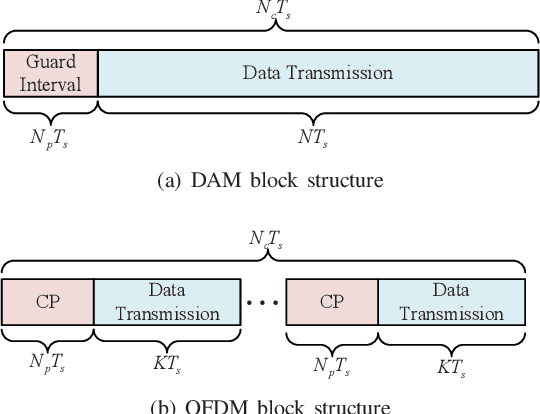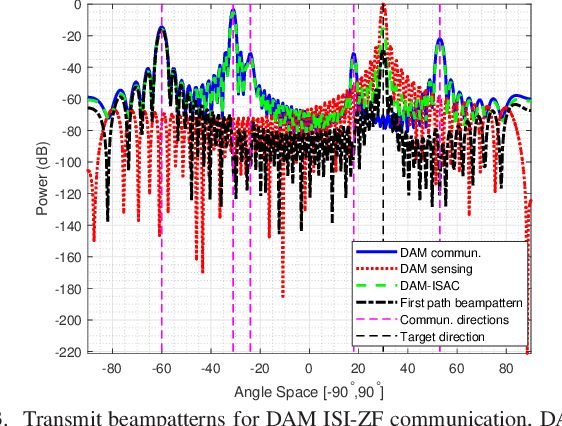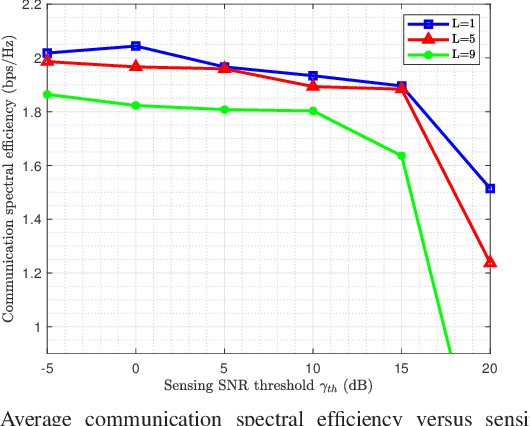Zhiqiang Xiao
Achieving Full-Bandwidth Sensing Performance with Partial Bandwidth Allocation for ISAC
Dec 28, 2024



Abstract:This letter studies an uplink integrated sensing and communication (ISAC) system using discrete Fourier transform spread orthogonal frequency division multiplexing (DFT-s-OFDM) transmission. We try to answer the following fundamental question: With only a fractional bandwidth allocated to the user with sensing task, can the same delay resolution and unambiguous range be achieved as if all bandwidth were allocated to it? We affirmatively answer the question by proposing a novel two-stage delay estimation (TSDE) method that exploits the following facts: without increasing the allocated bandwidth, higher delay resolution can be achieved via distributed subcarrier allocation compared to its collocated counterpart, while there is a trade-off between delay resolution and unambiguous range by varying the decimation factor of subcarriers. Therefore, the key idea of the proposed TSDE method is to first perform coarse delay estimation with collocated subcarriers to achieve a large unambiguous range, and then use distributed subcarriers with optimized decimation factor to enhance delay resolution while avoiding delay ambiguity. Our analysis shows that the proposed TSDE method can achieve the full-bandwidth delay resolution and unambiguous range, by using only at most half of the full bandwidth, provided that the channel delay spread is less than half of the unambiguous range. Numerical results show the superiority of the proposed method over the conventional method with collocated subcarriers.
Movable Antenna for Wireless Communications:Prototyping and Experimental Results
Aug 16, 2024Abstract:Movable antenna (MA), which can flexibly change the position of antenna in three-dimensional (3D) continuous space, is an emerging technology for achieving full spatial performance gains. In this paper, a prototype of MA communication system with ultra-accurate movement control is presented to verify the performance gain of MA in practical environments. The prototype utilizes the feedback control to ensure that each power measurement is performed after the MA moves to a designated position. The system operates at 3.5 GHz or 27.5 GHz, where the MA moves along a one-dimensional horizontal line with a step size of 0.01{\lambda} and in a two-dimensional square region with a step size of 0.05{\lambda}, respectively, with {\lambda} denoting the signal wavelength. The scenario with mixed line-of-sight (LoS) and non-LoS (NLoS) links is considered. Extensive experimental results are obtained with the designed prototype and compared with the simulation results, which validate the great potential of MA technology in improving wireless communication performance. For example, the maximum variation of measured power reaches over 40 dB and 23 dB at 3.5 GHz and 27.5 GHz, respectively, thanks to the flexible antenna movement. In addition, experimental results indicate that the power gain of MA system relies on the estimated path state information (PSI), including the number of paths, their delays, elevation and azimuth angles of arrival (AoAs), as well as the power ratio of each path.
Single-BS Simultaneous Environment Sensing and UE Localization without LoS Path by Exploiting Near-Field Scatterers
Jul 30, 2024Abstract:As the mobile communication network evolves over the past few decades, localizing user equipment (UE) has become an important network service. While localization in line-of-sight (LoS) scenarios has reached a level of maturity, it is known that in far-field scenarios without a LoS path nor any prior information about the scatterers, accurately localizing the UE is impossible. In this letter, we show that this becomes possible if there are scatterers in the near-field region of the base station (BS) antenna arrays. Specifically, by exploiting the additional distance sensing capability of extremely large-scale antenna arrays (XL-arrays) provided by near-field effects, we propose a novel method that simultaneously performs environment sensing and non-line-of-sight (NLoS) UE localization using one single BS. In the proposed method, the BS leverages the near-field characteristics of XL-arrays to directly estimate the locations of the near-field scatterers with array signal processing, which then serves as virtual anchors for UE localization. Then, the propagation delay for each path is estimated and the position of the UE is obtained based on the positions of scatterers and the path delays. Simulation results demonstrate that the proposed method achieves superior accuracy and robustness with similar complexity compared with benchmark methods.
Orthogonal Time Frequency Space with Delay-Doppler Alignment Modulation
Jul 08, 2024



Abstract:Delay-Doppler alignment modulation (DDAM) is a novel technique to mitigate time-frequency doubly selective channels by leveraging the high spatial resolution offered by large antenna arrays and multi-path sparsity of millimeter wave (mmWave) and TeraHertz (THz) channels. By introducing per-path delay and Doppler compensations, followed by path-based beamforming, it is possible to reshape the channel features with significantly reduced channel delay and Doppler spreads. This offers new degrees-of-freedom for waveform designs such as orthogonal time frequency space (OTFS), since the reshaped channel can significantly relax the constraints on OTFS parameter selection and reduce the complexity of signal detection at the receiver. Therefore, in this paper, by combing DDAM with OTFS, we propose a novel technique termed DDAM-OTFS. Two implementation schemes are introduced for DDAM-OTFS, namely path-based alignment and bin-based alignment. Simulation results are provided to demonstrate the superior performance of the proposed DDAM-OTFS in terms of spectral efficiency (SE) and peak-to-average power ratio (PAPR) compared to the conventional OTFS.
Rethinking Waveform for 6G: Harnessing Delay-Doppler Alignment Modulation
Jun 13, 2024



Abstract:Waveform design has served as a cornerstone for each generation of mobile communication systems. The future sixth-generation (6G) mobile communication networks are expected to employ larger-scale antenna arrays and exploit higher-frequency bands for further boosting data transmission rate and providing ubiquitous wireless sensing. This brings new opportunities and challenges for 6G waveform design. In this article, by leveraging the super spatial resolution of large antenna arrays and the multi-path spatial sparsity of highfrequency wireless channels, we introduce a new approach for waveform design based on the recently proposed delay-Doppler alignment modulation (DDAM). In particular, DDAM makes a paradigm shift of waveform design from the conventional manner of tolerating channel delay and Doppler spreads to actively manipulating them. First, we review the fundamental constraints and performance limitations of orthogonal frequency division multiplexing (OFDM) and introduce new opportunities for 6G waveform design. Next, the motivations and basic principles of DDAM are presented, followed by its various extensions to different wireless system setups. Finally, the main design considerations for DDAM are discussed and the new opportunities for future research are highlighted.
Fractional Delay Alignment Modulation for Spatially Sparse Wireless Communications
Mar 29, 2024Abstract:Delay alignment modulation (DAM) is a novel transmission technique for wireless systems with high spatial resolution by leveraging delay compensation and path-based beamforming, to mitigate the inter-symbol interference (ISI) without resorting to complex channel equalization or multi-carrier transmission. However, most existing studies on DAM consider a simplified scenario by assuming that the channel multi-path delays are integer multiples of the signal sampling interval. This paper investigates DAM for the more general and practical scenarios with fractional multi-path delays. We first analyze the impact of fractional multi-path delays on the existing DAM design, termed integer DAM (iDAM), which can only achieve delay compensations that are integer multiples of the sampling interval. It is revealed that the existence of fractional multi-path delays renders iDAM no longer possible to achieve perfect delay alignment. To address this issue, we propose a more generic DAM design called fractional DAM (fDAM), which achieves fractional delay pre-compensation via upsampling and fractional delay filtering. By leveraging the Farrow filter structure, the proposed approach can eliminate ISI without real-time computation of filter coefficients, as typically required in traditional channel equalization techniques. Simulation results demonstrate that the proposed fDAM outperforms the existing iDAM and orthogonal frequency division multiplexing (OFDM) in terms of symbol error rate (SER) and spectral efficiency, while maintaining a comparable peak-to-average power ratio (PAPR) as iDAM, which is considerably lower than OFDM.
Integrated Sensing and Channel Estimation by Exploiting Dual Timescales for Delay-Doppler Alignment Modulation
Oct 17, 2023Abstract:For integrated sensing and communication (ISAC) systems, the channel information essential for communication and sensing tasks fluctuates across different timescales. Specifically, wireless sensing primarily focuses on acquiring path state information (PSI) (e.g., delay, angle, and Doppler) of individual multi-path components to sense the environment, which usually evolves much more slowly than the composite channel state information (CSI) required for communications. Typically, the CSI is approximately unchanged during the channel coherence time, which characterizes the statistical properties of wireless communication channels. However, this concept is less appropriate for describing that for wireless sensing. To this end, in this paper, we introduce a new timescale to study the variation of the PSI from a channel geometric perspective, termed path invariant time, during which the PSI largely remains constant. Our analysis indicates that the path invariant time considerably exceeds the channel coherence time. Thus, capitalizing on these dual timescales of the wireless channel, in this paper, we propose a novel ISAC framework exploiting the recently proposed delay-Doppler alignment modulation (DDAM) technique. Different from most existing studies on DDAM that assume the availability of perfect PSI, in this work, we propose a novel algorithm, termed as adaptive simultaneously orthogonal matching pursuit with support refinement (ASOMP-SR), for joint environment sensing and PSI estimation. We also analyze the performance of DDAM with imperfectly sensed PSI.Simulation results unveil that the proposed DDAM-based ISAC can achieve superior spectral efficiency and a reduced peak-to-average power ratio (PAPR) compared to standard orthogonal frequency division multiplexing (OFDM).
EPCFormer: Expression Prompt Collaboration Transformer for Universal Referring Video Object Segmentation
Aug 08, 2023



Abstract:Audio-guided Video Object Segmentation (A-VOS) and Referring Video Object Segmentation (R-VOS) are two highly-related tasks, which both aim to segment specific objects from video sequences according to user-provided expression prompts. However, due to the challenges in modeling representations for different modalities, contemporary methods struggle to strike a balance between interaction flexibility and high-precision localization and segmentation. In this paper, we address this problem from two perspectives: the alignment representation of audio and text and the deep interaction among audio, text, and visual features. First, we propose a universal architecture, the Expression Prompt Collaboration Transformer, herein EPCFormer. Next, we propose an Expression Alignment (EA) mechanism for audio and text expressions. By introducing contrastive learning for audio and text expressions, the proposed EPCFormer realizes comprehension of the semantic equivalence between audio and text expressions denoting the same objects. Then, to facilitate deep interactions among audio, text, and video features, we introduce an Expression-Visual Attention (EVA) mechanism. The knowledge of video object segmentation in terms of the expression prompts can seamlessly transfer between the two tasks by deeply exploring complementary cues between text and audio. Experiments on well-recognized benchmarks demonstrate that our universal EPCFormer attains state-of-the-art results on both tasks. The source code of EPCFormer will be made publicly available at https://github.com/lab206/EPCFormer.
Cramér-Rao Bounds for Near-Field Sensing with Extremely Large-Scale MIMO
Mar 10, 2023Abstract:Mobile communication networks were designed to mainly support ubiquitous wireless communications, yet they are also expected to achieve radio sensing capabilities in the near future. However, most prior studies on radio sensing usually rely on far-field assumption with uniform plane wave (UPW) models. With the ever-increasing antenna size, together with the growing demands to sense nearby targets, the conventional far-field UPW assumption may become invalid. Therefore, this paper studies near-field radio sensing with extremely large-scale (XL) antenna arrays, where the more general uniform spheric wave (USW) sensing model is considered. Closed-form expressions of the Cram\'er-Rao Bounds (CRBs) for both angle and range estimations are derived for near-field XL-MIMO radar mode and XL-phased array radar mode, respectively. Our results reveal that different from the conventional UPW model where the CRB for angle decreases unboundedly as the number of antennas increases, for XL-MIMO radar-based near-field sensing, the CRB decreases with diminishing return and approaches to a certain limit as the number of antennas increases. Besides, different from the far-field model where the CRB for range is infinity since it has no range estimation capability, that for the near-field case is finite. Furthermore, it is revealed that the commonly used spherical wave model based on second-order Taylor approximation is insufficient for near-field CRB analysis. Extensive simulation results are provided to validate our derived CRBs.
Integrated Sensing and Communication with Delay Alignment Modulation: Performance Analysis and Beamforming Optimization
Jul 08, 2022



Abstract:Delay alignment modulation (DAM) has been recently proposed to enable manipulable channel delay spread for efficient single- or multi-carrier communications. In particular, with perfect delay alignment, inter-symbol interference (ISI) can be eliminated even with single-carrier (SC) transmission, without relying on sophisticated channel equalization. The key ideas of DAM are delay pre-compensation and path-based beamforming, so that all multi-path signal components may arrive at the receiver simultaneously and be superimposed constructively, rather than causing the detrimental ISI. Compared to the classic orthogonal frequency division multiplexing (OFDM) transmission, DAM-enabled SC communication has several appealing advantages, including low peak-to-average-power ratio (PAPR) and high tolerance for Doppler frequency shift, which renders DAM also appealing for radar sensing. Therefore, in this paper, DAM is investigated for integrated sensing and communication (ISAC) systems. We first study the output signal-to-noise ratios (SNRs) for ISI-free SC communication and radar sensing, and then derive the closed-form expressions for DAM-based sensing in terms of the ambiguity function (AF) and integrated sidelobe ratio (ISR). Furthermore, we study the beamforming design problem for DAM-based ISAC to maximize the communication SNR while guaranteeing the sensing performance in terms of the sensing SNR and ISR. Finally, we provide performance comparison between DAM and OFDM for ISAC, and it is revealed that DAM signal may achieve better communication and sensing performance, thanks to its low PAPR, reduced guard interval overhead, as well as higher tolerance for Doppler frequency shift. Simulation results are provided to show the great potential of DAM for ISAC.
 Add to Chrome
Add to Chrome Add to Firefox
Add to Firefox Add to Edge
Add to Edge